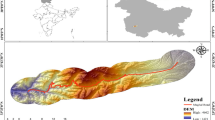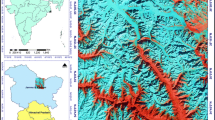Abstract
The aim of this study is to generate a reliable dynamic snow avalanche hazard map using analytical hierarchy process method based on multisource geo-spatial data for the Chowkibal–Tangdhar (C–T) road axis in Jammu and Kashmir (J&K), India. Avalanche-prone areas of C–T axis have been demarcated using three causative parameters, i.e., terrain, ground cover and meteorological parameters. Terrain parameters, e.g., elevation, slope, aspect and curvature, have been estimated from Advanced Spaceborne Thermal Emission and Reflection Radiometer, Global Digital Elevation Model Version 2. Ground cover information has been extracted from Landsat-8 data. Meteorological parameters maps, i.e., snow depth, relative humidity and air temperature, have been generated using geo-spatial interpolation techniques of in situ data. All the parameters have been incorporated in Geographic Information System environment to generate the hazard map. Validation of hazard map was accomplished with the area under the curve method. The prediction rate was observed to be 93.2%. Further, 20% of the study area was estimated having no hazard, 55% as low hazard, 12% as moderate hazard and 13% as high hazard on April 13, 2015. Dynamic hazard map thus generated using remote sensing and in situ data will be useful for mitigation of snow avalanche hazard, regional planning for development of infrastructure, transportation, troops movement, army deployments and communication network.







Similar content being viewed by others
References
Abdul, A. A., Naqvi, H. R., & Firdouse, Z. (2015). An assessment and identification of avalanche hazard sites in Uri sector and its surroundings on Himalayan mountain. Journal of Mountain Science, 12(6), 1499–1510. https://doi.org/10.1007/s11629-014-3274-z.
Bahuguna, I. M., Kulkarni, A. V., Nayak, S., Rathore, B. P., Negi, H. S., & Mathur, P. (2007). Himalayan glacier retreat using IRS 1C PAN stereo data. International Journal of Remote Sensing, 28, 437–442.
Bathrellos, G. D., Gaki-Papanastassiou, K., Skilodimou, H. D., Papanastassiou, D., & Chousianitis, K. G. (2012). Potential suitability for urban planning and industry development using natural hazard maps and geological-geomorphological parameters. Environmental Earth Sciences, 66(2), 537–548. https://doi.org/10.1007/s12665-011-1263-x.
Bellaire, S., Jamieson, J. B., & Fierz, C. (2011). Forcing the snow-cover model SNOWPACK with forecasted weather data. Cryosphere, 5(4), 1115–1125. https://doi.org/10.5194/tc-5-1115-2011.
Buck, A. L. (1981). New equations for computing vapor pressure and enhancement factor. Journal of Applied Meteorology, 20(12), 1527–1532. https://doi.org/10.1175/1520-0450(1981)020%3c1527:NEFCVP%3e2.0.CO;2.
Bui, D. T., Lofman, O., Revhaug, I., & Dick, O. (2011). Landslide susceptibility analysis in the Hoa Binh province of Vietnam using statistical index and logistic regression. Natural Hazards, 59(3), 1413–1444. https://doi.org/10.1007/s11069-011-9844-2.
Chang, C. L., & Chao, Y. C. (2012). Using the analytical hierarchy process to assess the environmental vulnerabilities of basins in Taiwan. Environmental Monitoring and Assessment, 184(5), 2939–2945. https://doi.org/10.1007/s10661-011-2162-z.
Chen, V. Y. C., Lien, H. P., Liu, C. H., Liou, J. J. H., Tzeng, G. H., & Yang, L. S. (2011). Fuzzy MCDM approach for selecting the best environment-watershed plan. Applied Soft Computing Journal, 11(1), 265–275. https://doi.org/10.1016/j.asoc.2009.11.017.
Colbeck, S., Akiyaya, E., Armstrong, R. (1990). International classification of seasonal snow on the ground. In International commission for snow and ice (IAHS), world data center for glaciology of Colorado, Boulder, CO, USA.
Dai, F. C., Lee, C. F., Li, J., & Xu, Z. W. (2001). Assessment of landslide susceptibility on the natural terrain of Lantau Island, Hong Kong. Environmental Geology, 43(3), 381–391.
Dewali, S. K. (2010). A prototype model for integration of topographical and meteorological parameters for avalanche hazard analysis. DRDO Science Spectrum (pp. 27–36).
Dewali, S. K., Mani, S., Singh, P. S., & Sarwade, R. N. (2009). A GIS-based avalanche hazard zonation scheme for NW Himalaya using topographical and meteorological variables. In Proceedings of international symposium on snow and avalanches (ISSA-09), Manali, India, April 6–10, 2009 (pp. 99–107).
Dimri, A. P., Niyogi, D., Barros, A. P., Ridley, J., Mohanty, U. C., Yasunari, T., et al. (2015). Western disturbances: A review. Reviews of Geophysics. https://doi.org/10.1002/2014RG000460.
Ezzati, S., Najafi, A., & Bettinger, P. (2016). Finding feasible harvest zones in mountainous areas using integrated spatial multi-criteria decision analysis. Land Use Policy, 59, 478–491. https://doi.org/10.1016/j.landusepol.2016.09.020.
Gusain, H. S., Chand, D., Thakur, N., Singh, A., Ganju, A. (2009). Snow avalanche climatology of Indian western Himalaya. In International symposium on snow and avalanches (ISSA), 6–10 April, Manali, India.
Gusain, H. S., Kala, M., Ganju, A., Mishra, V. D., & Snehmani, (2015). Observations of snow-meteorological parameters in Gangotri glacier region. Current Science, 109(11), 2116–2120. https://doi.org/10.18520/v109/i11/2116-2120.
Gusain, H. S., Mishra, V. D., & Arora, M. K. (2014). Estimation of net shortwave radiation flux of western Himalayan snow cover during clear sky days using remote sensing and meteorological data. Remote Sensing Letters, 5, 83–92.
Gusain, H. S., Mishra, V. D., Arora, M. K., Mamgain, S., & Singh, D. K. (2016). Operational algorithm for generation of snow depth maps from discrete data in Indian western Himalaya. Cold Regions Science and Technology, 126, 22–29. https://doi.org/10.1016/j.coldregions.2016.02.012.
Gusain, H. S., Mishra, V., & Singh, D. K. (2018). Study of a snow avalanche accident along Chowkibal–Tangdhar road in Kupwara district, Jammu and Kashmir, India. Current Science, 115(05), 969–972. https://doi.org/10.18520/cs/v115/i5/962-969.
Jaafari, A., Najafi, A., Pourghasemi, H. R., Rezaeian, J., & Sattarian, A. (2014). GIS-based frequency ratio and index of entropy models for landslide susceptibility assessment in the Caspian forest, northern Iran. International Journal of Environmental Science and Technology, 11(4), 909–926. https://doi.org/10.1007/s13762-013-0464-0.
Joshi, J. C., & Srivastava, S. (2014). A hidden Markov model for avalanche forecasting on Chowkibal–Tangdhar road axis in Indian Himalayas. Journal of Earth System Science, 123(8), 1771–1779. https://doi.org/10.1007/s12040-014-0510-4.
König, M., Winther, J. G., & Isaksson, E. (2001). Measuring snow and glacier ice properties from satellite. Reviews of Geophysics, 39(1), 1–27. https://doi.org/10.1029/1999RG000076.
Krishna, A. P. (1996). Cover: Satellite remote sensing applications for snow cover characterization in the morphogenetic regions of upper Tista river basin, Sikkim Himalaya. International Journal of Remote Sensing, 17(4), 651–656. https://doi.org/10.1080/01431169608949035.
Kulkarni, A. V., & Bahuguna, I. M. (2002). Glacial retreat in the Baspa basin, Himalayas, monitored with satellite stereo data. Journal of Glaciology, 48, 171–172.
Kumar, S., Snehmani, Srivastava, P. K., Gore, A., & Singh, M. K. (2016). Fuzzy–frequency ratio model for avalanche susceptibility map**. International Journal of Digital Earth, 9(12), 1168–1184. https://doi.org/10.1080/17538947.2016.1197328.
Maestro, A., Somoza, L., Medialdea, T., Talbot, C. J., Lowrie, A., Vázquez, J. T., et al. (2003). Large-scale slope failure involving Triassic and middle Miocene salt and shale in the Gulf of Cádiz (Atlantic Iberian Margin). Terra Nova, 15(6), 380–391. https://doi.org/10.1046/j.1365-3121.2003.00513.x.
McClung, D. M. (2002). The elements of applied avalanche forecasting part I: The human issues. Natural Hazards, 26(2), 111–129. https://doi.org/10.1023/A:1015665432221.
McClung, D. M., & Schaerer, P. (2006). The avalanche handbook (3rd ed.). Seattle, WA: The Mountaineers Books.
Nagarajan, R., Venkataraman, G., & Snehmani, (2014). Rule based classification of potential snow avalanche areas. Natural Resources and Conservation, 2(2), 11–24.
Pourghasemi, H. R., Moradi, H. R., Fatemi Aghda, S. M., Gokceoglu, C., & Pradhan, B. (2014). GIS-based landslide susceptibility map** with probabilistic likelihood ratio and spatial multi-criteria evaluation models (North of Tehran, Iran). Arabian Journal of Geosciences, 7(5), 1857–1878. https://doi.org/10.1007/s12517-012-0825-x.
Pradhan, B. (2013). A comparative study on the predictive ability of the decision tree, support vector machine and neuro-fuzzy models in landslide susceptibility map** using GIS. Computers & Geosciences, 51, 350–365. https://doi.org/10.1016/j.cageo.2012.08.023.
Saaty, T. L. (1977). A scaling method for priorities in hierarchical structures. Journal of Mathematical Psychology, 15(3), 234–281. https://doi.org/10.1016/0022-2496(77)90033-5.
Saaty, T. L. (1980). The analytic hierarchy process. Education. https://doi.org/10.3414/ME10-01-0028.
Saaty, T. L. (1988). What is the analytic hierarchy process? In G. Mitra, H. Greenberg, F. Lootsma, M. Rijkaert, & H. Zimmermann (Eds.), Mathematical models for decision support (pp. 109–121). Berlin, Heidelberg: Springer.
Saaty, T. L., & Vargas, L. G. (2001). Models, methods, concepts and applications of the analytic hierarchy process (Vol. 175). Berlin: Springer. https://doi.org/10.1007/978-1-4615-1665-1.
Schweizer, J., Jamieson, B., & Reuter, B. (2013). How surface warming affects dry-snow instability. The Avalanche Review, 31(3), 25–31.
Sharma, S. S., & Ganju, A. (2000). Complexities of avalanche forecasting in Western Himalaya—An overview. Cold Regions Science and Technology, 31(2), 95–102. https://doi.org/10.1016/S0165-232X(99)00034-8.
Sharma, V., Mishra, V. D., & Joshi, P. K. (2014). Topographic controls on spatio-temporal snow cover distribution in Northwest Himalaya. International Journal of Remote Sensing, 35(9), 3036–3056. https://doi.org/10.1080/01431161.2014.894665.
Singh, D. K., Gusain, H. S., Mishra, V., & Gupta, N. (2018a). Automated retrieval of snow/ice surface broadband albedo in Beas River Basin, India using landsat-8 satellite images and validation with wireless sensor network data. Journal of the Indian Society of Remote Sensing. https://doi.org/10.1007/s12524-018-0863-2.
Singh, D. K., Gusain, H. S., Mishra, V., & Gupta, N. (2018b). Snow cover variability in North-West Himalaya during last decade. Arabian Journal of Geosciences. https://doi.org/10.1007/s12517-018-3926-3.
Singh, D. K., Gusain, H. S., Mishra, V., Gupta, N., & Das, R. K. (2018c). Automated map** of snow/ice surface temperature using Landsat-8 data in Beas River basin, India, and validation with wireless sensor network data. Arabian Journal of Geosciences. https://doi.org/10.1007/s12517-018-3497-3.
Singh, D. K., Singh, K. K., Mishra, V. D., & Sharma, J. K. (2012). Formulation of snow depth algorithms for different regions of NW-Himalaya using passive microwave satellite data. International Journal of Engineering Research & Technology, 1(5), 1–9.
Singh, K. K., DewaIi, S. K., Singh, D. K., Mishra, V. D., & Kaur, M. (2016). Monitoring of snow surface temperature in North-West Himalaya using passive microwave satellite data. Indian Journal of Radio & Space Physics, 45(March), 20–29.
Singh, K. K., Mishra, V. D., Singh, D. K., & Ganju, A. (2013). Estimation of snow surface temperature for NW Himalayan regions using passive microwave satellite data. Indian Journal of Radio & Space Physics, 42(February), 27–33.
Snehmani, Bhardwaj, A., Pandit, A., & Ganju, A. (2014). Demarcation of potential avalanche sites using remote sensing and ground observations: A case study of Gangotri glacier. Geocarto International, 29(5), 520–535. https://doi.org/10.1080/10106049.2013.807304.
Tachikawa, T., Hato, M., Kaku, M., & Iwasaki, A. (2011). Characteristics of ASTER GDEM version 2. In International geoscience and remote sensing symposium (IGARSS) (pp. 3657–3660). https://doi.org/10.1109/IGARSS.2011.6050017.
United Nations. (2004). Living with risk. Geneva: United Nations.
Acknowledgements
The authors are grateful to Shri. Naresh Kumar, Director, Snow and Avalanche Study Establishment (SASE), Chandigarh, for providing facilities to carry out this work and constant motivation during the investigation. The authors would like to acknowledge SASE staff for collecting ground data. We are also thankful to Shri. S. K. Dewali, Shri. Dhirender and Manoj Kumar for providing technical support during the preparation of the manuscript. Authors are thankful to http://earthexplorer.usgs.gov/, USGS for providing Landsat-8 data and GDEM.
Author information
Authors and Affiliations
Corresponding author
About this article
Cite this article
Singh, D.K., Mishra, V.D., Gusain, H.S. et al. Geo-spatial Modeling for Automated Demarcation of Snow Avalanche Hazard Areas Using Landsat-8 Satellite Images and In Situ Data. J Indian Soc Remote Sens 47, 513–526 (2019). https://doi.org/10.1007/s12524-018-00936-w
Received:
Accepted:
Published:
Issue Date:
DOI: https://doi.org/10.1007/s12524-018-00936-w




